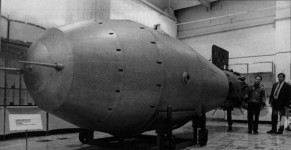Denis a écrit :Pourrais tu, aussi, le faire tomber un peu plus loin? À 5000 km, par exemple.

Denis
Salut Denis. Bonne nouvelle.
A 5000 km. tu gardes ton toupet intact.
Your Inputs:
Distance from Impact: 5000.00 km = 3105.00 miles
Projectile Diameter: 400.00 m = 1312.00 ft = 0.25 miles
Projectile Density: 3000 kg/m3
Impact Velocity: 17.00 km/s = 10.56 miles/s
Impact Angle: 45 degrees
Target Density: 2500 kg/m3
Target Type: Sedimentary Rock
Energy:
Energy before atmospheric entry: 1.45 x 1019 Joules = 3.47 x 103 MegaTons TNT
The average interval between impacts of this size somewhere on Earth during the last 4 billion years is 5.9 x 104years
Atmospheric Entry:
The projectile begins to breakup at an altitude of 54000 meters = 177000 ft
The projectile reaches the ground in a broken condition. The mass of projectile strikes the surface at velocity 15.6 km/s = 9.71 miles/s
The impact energy is 1.23 x 1019 Joules = 2.94 x 103MegaTons.
The broken projectile fragments strike the ground in an ellipse of dimension 1.26 km by 0.893 km
Major Global Changes:
The Earth is not strongly disturbed by the impact and loses negligible mass.
The impact does not make a noticeable change in the Earth's rotation period or the tilt of its axis.
The impact does not shift the Earth's orbit noticeably.
Crater Dimensions:
Crater shape is normal in spite of atmospheric crushing; fragments are not significantly dispersed.
Transient Crater Diameter: 4.99 km = 3.1 miles
Transient Crater Depth: 1.76 km = 1.1 miles
Final Crater Diameter: 6.19 km = 3.84 miles
Final Crater Depth: 0.512 km = 0.318 miles
The crater formed is a complex crater.
The volume of the target melted or vaporized is 0.0774 km3 = 0.0186 miles3
Roughly half the melt remains in the crater , where its average thickness is 3.96 meters = 13 feet
Thermal Radiation:
The fireball is below the horizon. There is no direct thermal radiation.
Seismic Effects:
The major seismic shaking will arrive at approximately 1000 seconds.
Richter Scale Magnitude: 6.9
Mercalli Scale Intensity at a distance of 5000 km:
Nothing would be felt. However, seismic equipment may still detect the shaking.
Ejecta:
Almost no solid ejecta reaches this site.
Air Blast:
The air blast will arrive at approximately 15200 seconds.
Peak Overpressure: 157 Pa = 0.00157 bars = 0.0222 psi
Max wind velocity: 0.369 m/s = 0.826 mph
Sound Intensity: 44 dB (Easily Heard)
Toupet :
Intact
============
Recalculé à 100 Km avec un diametre corrigé de 400m.
Your Inputs:
Distance from Impact: 100.00 km = 62.10 miles
Projectile Diameter: 400.00 m = 1312.00 ft = 0.25 miles
Projectile Density: 3000 kg/m3
Impact Velocity: 17.00 km/s = 10.56 miles/s
Impact Angle: 45 degrees
Target Density: 2500 kg/m3
Target Type: Sedimentary Rock
Energy:
Energy before atmospheric entry: 1.45 x 1019 Joules = 3.47 x 103 MegaTons TNT
The average interval between impacts of this size somewhere on Earth during the last 4 billion years is 5.9 x 104years
Atmospheric Entry:
The projectile begins to breakup at an altitude of 54000 meters = 177000 ft
The projectile reaches the ground in a broken condition. The mass of projectile strikes the surface at velocity 15.6 km/s = 9.71 miles/s
The impact energy is 1.23 x 1019 Joules = 2.94 x 103MegaTons.
The broken projectile fragments strike the ground in an ellipse of dimension 1.26 km by 0.893 km
Major Global Changes:
The Earth is not strongly disturbed by the impact and loses negligible mass.
The impact does not make a noticeable change in the Earth's rotation period or the tilt of its axis.
The impact does not shift the Earth's orbit noticeably.
Crater Dimensions:
Crater shape is normal in spite of atmospheric crushing; fragments are not significantly dispersed.
Transient Crater Diameter: 4.99 km = 3.1 miles
Transient Crater Depth: 1.76 km = 1.1 miles
Final Crater Diameter: 6.19 km = 3.84 miles
Final Crater Depth: 0.512 km = 0.318 miles
The crater formed is a complex crater.
The volume of the target melted or vaporized is 0.0774 km3 = 0.0186 miles3
Roughly half the melt remains in the crater , where its average thickness is 3.96 meters = 13 feet
Thermal Radiation:
Time for maximum radiation: 0.295 seconds after impact
Visible fireball radius: 3.83 km = 2.38 miles
The fireball appears 8.71 times larger than the sun
Thermal Exposure: 4.61 x 104 Joules/m2
Duration of Irradiation: 6 seconds
Radiant flux (relative to the sun): 7.68
Seismic Effects:
The major seismic shaking will arrive at approximately 20 seconds.
Richter Scale Magnitude: 6.9
Mercalli Scale Intensity at a distance of 100 km:
VI. Felt by all, many frightened. Some heavy furniture moved; a few instances of fallen plaster. Damage slight.
VII. Damage negligible in buildings of good design and construction; slight to moderate in well-built ordinary structures; considerable damage in poorly built or badly designed structures; some chimneys broken.
Ejecta:
The ejecta will arrive approximately 144 seconds after the impact.
At your position the ejecta arrives in scattered fragments
Average Ejecta Thickness: 5.54 mm = 0.218 inches
Mean Fragment Diameter: 3.85 cm = 1.52 inches
Air Blast:
The air blast will arrive at approximately 303 seconds.
Peak Overpressure: 15200 Pa = 0.152 bars = 2.16 psi
Max wind velocity: 33.8 m/s = 75.6 mph
Sound Intensity: 84 dB (Loud as heavy traffic)
Damage Description:
Glass windows will shatter.
Toupet :
Disturbed
I.

